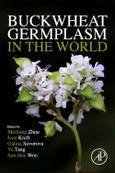Buckwheat Germplasm in the World offers an overview of this globally important crop, including its general characterization and genetic diversity-particularly in Russia, China, India and Eastern Europe. The book presents the latest research on molecular marker development, genetics and phenotype analysis of new wild buckwheat to examine the nutritional values of this pseudocereal crop. Due to its short growth span, ability to grow at high altitudes and the high quality of its protein content, buckwheat is considered an important crop for addressing global food needs. Ideal for researchers and advanced-level students seeking better understanding of the buckwheat germplasm.
Please Note: This is an On Demand product, delivery may take up to 11 working days after payment has been received.
Table of Contents
1. Overview of buckwheat resourses in the world 2. Classification and nomenclature of buckwheat plants 3. Distribution of buckwheat resourses in the world 4. Chromosome of Fagopyrum 5. Description of cultivated tatary buckwheat 6. Description of cultivated common buckwheat 7. Perennial wild Fagopyrum species-Self-incompatible 8. Perennial wild Fagopyrum species-Self-compatible 9. Annual wild Fagopyrum species-Self-incompatible 10. Annual wild Fagopyrum species-Self-compatible 11. Annual wild Fagopyrum species-Partially self-compatible 12. Molecular evolution of wild species and cultivated 13. Utilization of wild buckwheat species 14. Buckwheat genetic resources in central Europe 15. Existing variability and future prospects of buckwheat germplasm in the Himalayan tract 16. Undefined title 17. Effective use of genome-wide markers to breeding for quantitative traits in common buckwheat 18. Genetic diversity of Russian buckwheat cultivars assessed from nuclear and organellar gene sequences 19. Genetic polymorphism of common buckwheat (Fagopyrum esculentum Moench.), formed from evolutionary mutation reserve of the cultivar 20. Cultivation of Fagopyrum tataricum and Fagopyrum esculentum in order to obtain raw material with high rutin content in the Far East of Russia 21. Phytochemicals and their biofunctional properties of different buckwheat germplasms for functional food 22. Rutin content assessment of Tartary buckwheat germplasm cultivated in Italy Topic: Grain rutin content evaluation of a collection of approximatively 100 F. tataricum accessions 23. Correlation between grain yield and rutin content in common buckwheat germplasm cultivated in Southern Italy 24. Buckwheat resources in the VIR (Russia) collection: Photoperiod response 25. Main morphological types of cultivated buckwheat populations in Russia 26. Interspecific crosses between Fagopyrum cymosum and other species through embryo culture techniques 27. Cell cultures of Fagopyrum tataricum as a source of biologically active phenolic compounds 28. Molecular genetics of Buckwheat and its role in crop improvement
Authors
Meiliang Zhou Biotechnology Research Institute, Chinese Academy of Agricultural Sciences (CAAS), Beijing, China.Dr. Meiliang Zhou (Biotechnology Research Institute-CAAS/Sichuan Agricultural University, China), Regulation of gene expression; Plant development; Functional genomics; Hormones signaling transduction mechanisms; Plant-biotic (microbe, insect and virus) interaction; Plant-abiotic (drought, salt, flooding, heavy metals, cold and high temperature); Plant secondary metabolites biosynthesis pathway and regulation mechanism; Plant nutrition.
Ivan Kreft University of Ljubljana/Slovenian Forestry Institute, Slovenia.
Prof. Dr. Ivan Kreft (University of Ljubljana/Slovenian Forestry Institute, Slovenia)studied agronomy and biology in Ljubljana (Slovenia - Dipl. Eng. Agr., Teacher of Biol., PhD) and in Lund (Sweden - Fil. Kand., MSc.). After employments in Germany and Sweden, he was appointed as researcher and teacher at University of Ljubljana, where he was retired as Professor in 2012. Since 2003 he is a member of Slovenian Academy of Science and Arts. He was holding lectures at many Universities including Maribor, Krizevci, Zagreb, Wien, Udine, Roma, Lisboa, Porto, Lund, Uppsala, Nitra, Minsk, several Universities in China, in Korea, and on several Universities in Japan. In the period 1992/93 he was Visiting Professor at Kyoto University, Japan, in 2001 he received a title of Visiting Professor at Shanxi University (Taiyuan, China), in April and May 2010 he was again in Japan, Visiting Professor at Kobe Gakuin University, Faculty of Nutrition, in Kobe. Since 2013 he is employed at the Slovenian Forestry Institute, Ljubljana, Slovenia. Field research on crops, especially buckwheat, and traditional food materials of plant origin
Galina Suvorova All-Russia Research Institute of Legumes and Groat Crops, Orel, Russia.
Head of the Laboratory of Genetics and Biotechnology
All-Russia Research Institute of Legumes and Groat Crops, Orel, Russia
Her research interests include genetics, interspecific hybridization, tissue culture, and molecular markers
Yu Tang Biotechnology Research Institute, Chinese Academy of Agricultural Sciences, Beijing, China Department of Food Science, Sichuan Tourism University, Chengdu, Sichuan, China.
Sun-Hee Woo College of Agriculture, Life & Environment Science, Chungbuk National University, Cheongju, Korea.
Prof. Dr. Sun-Hee Woo (Chungbuk National University, Korea),
Research interests in Molecular Genetics and Breeding of Crops and Crop Functional Genomics and Proteomics . Awards:
Award for Japanese Society of Breeding
Best Research Presentation Award from the Korean Breeding Science Society
Best Research Presentation Award from the International Plant Biotechnology Congress with J. of Plant Physiology
Best Research Presentation Award from the Korean Crop Science Society
Best Research Presentation Award from the Korean Plant Biotechnology Society
Best Research Award from the Korean Biochemistry and Molecular Biology Society
Excellent Paper Award, Korea Federation on Science & Technology Societies








